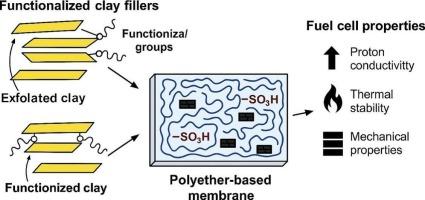Functionalized clay nanocomposites for enhanced proton conductivity in polyether-based fuel cell membranes
IF 5.8
2区 地球科学
Q2 CHEMISTRY, PHYSICAL
引用次数: 0
Abstract
This review critically examines the recent progress in the development of sulfonated polyether sulfone (SPES) and its derivatives (including sulfonated polyether sulfone with open sulfonic acid groups (SPESOS)) as functional matrices for next-generation proton exchange membrane (PEM) fuel cells. SPES-based membranes offer a tunable backbone, excellent thermal and mechanical stability, and chemical resistance, yet they often suffer from reduced proton conductivity and hydration stability under low-humidity or high-temperature conditions. To overcome these limitations, the integration of functionalized clay nanomaterials such as montmorillonite (Mt), layered double hydroxides (LDHs), and sepiolite (Sep) has emerged as a promising strategy. We discuss how these clays improve ionic domain morphology, water uptake, and mechanical reinforcement through molecular-level interactions with sulfonic acid sites. The review highlights scalable fabrication routes (e.g., solution casting, electrospinning, additive manufacturing), performance under realistic operating conditions, and comparisons with commercial Nafion membranes. Particular attention is given to structure property relationships, transport mechanisms, and interfacial engineering strategies that enable defect-free, high-conductivity membranes. Finally, challenges and future perspectives are addressed to guide sustainable, cost-effective membrane design for advanced electrochemical energy systems.

增强聚醚基燃料电池膜中质子导电性的功能化粘土纳米复合材料
本文综述了磺化聚醚砜(SPES)及其衍生物(包括开磺酸基磺化聚醚砜(SPESOS))作为下一代质子交换膜(PEM)燃料电池功能基质的最新进展。基于spes的膜具有可调节的骨架、优异的热稳定性和机械稳定性以及耐化学性,但在低湿度或高温条件下,它们的质子导电性和水合稳定性往往会降低。为了克服这些限制,整合功能化粘土纳米材料,如蒙脱土(Mt)、层状双氢氧化物(LDHs)和海泡石(Sep)已成为一种有前途的策略。我们讨论了这些粘土如何通过与磺酸位点的分子水平相互作用改善离子域形态、吸水和机械强化。这篇综述强调了可扩展的制造路线(例如,溶液铸造、静电纺丝、增材制造),在实际操作条件下的性能,以及与商业Nafion膜的比较。特别关注结构性质关系,传输机制和界面工程策略,使无缺陷,高导电性膜。最后,提出了挑战和未来的展望,以指导可持续的、具有成本效益的先进电化学能源系统膜设计。
本文章由计算机程序翻译,如有差异,请以英文原文为准。
求助全文
约1分钟内获得全文
求助全文
来源期刊

Applied Clay Science
地学-矿物学
CiteScore
10.30
自引率
10.70%
发文量
289
审稿时长
39 days
期刊介绍:
Applied Clay Science aims to be an international journal attracting high quality scientific papers on clays and clay minerals, including research papers, reviews, and technical notes. The journal covers typical subjects of Fundamental and Applied Clay Science such as:
• Synthesis and purification
• Structural, crystallographic and mineralogical properties of clays and clay minerals
• Thermal properties of clays and clay minerals
• Physico-chemical properties including i) surface and interface properties; ii) thermodynamic properties; iii) mechanical properties
• Interaction with water, with polar and apolar molecules
• Colloidal properties and rheology
• Adsorption, Intercalation, Ionic exchange
• Genesis and deposits of clay minerals
• Geology and geochemistry of clays
• Modification of clays and clay minerals properties by thermal and physical treatments
• Modification by chemical treatments with organic and inorganic molecules(organoclays, pillared clays)
• Modification by biological microorganisms. etc...
 求助内容:
求助内容: 应助结果提醒方式:
应助结果提醒方式:


